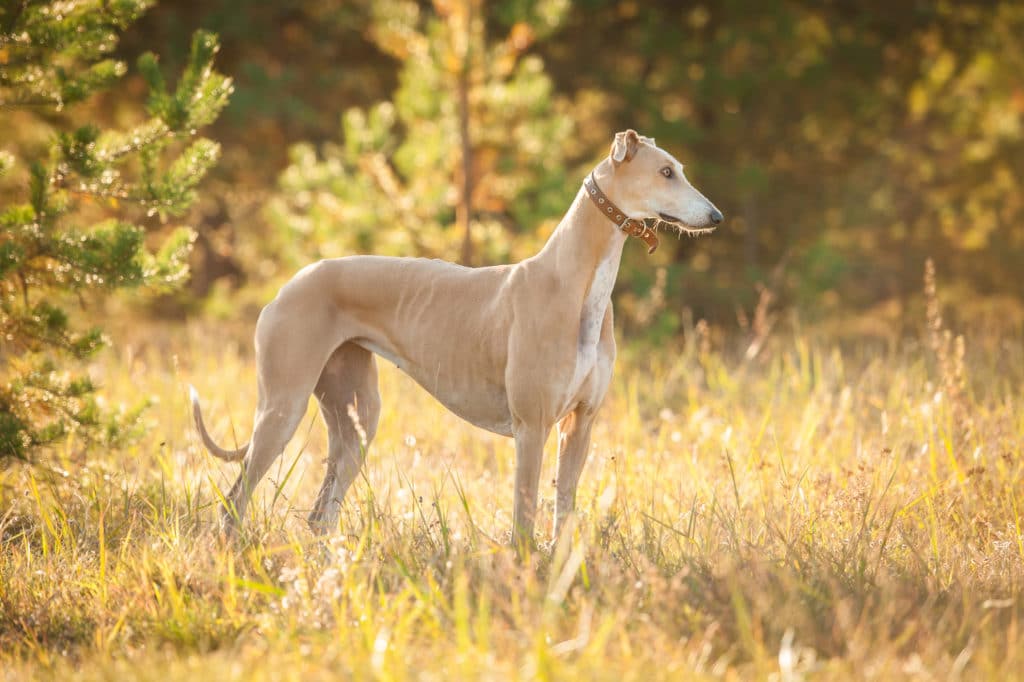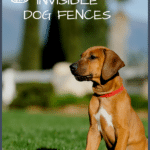5 Best Invisible (Underground) Dog Fences with our Installation Guide
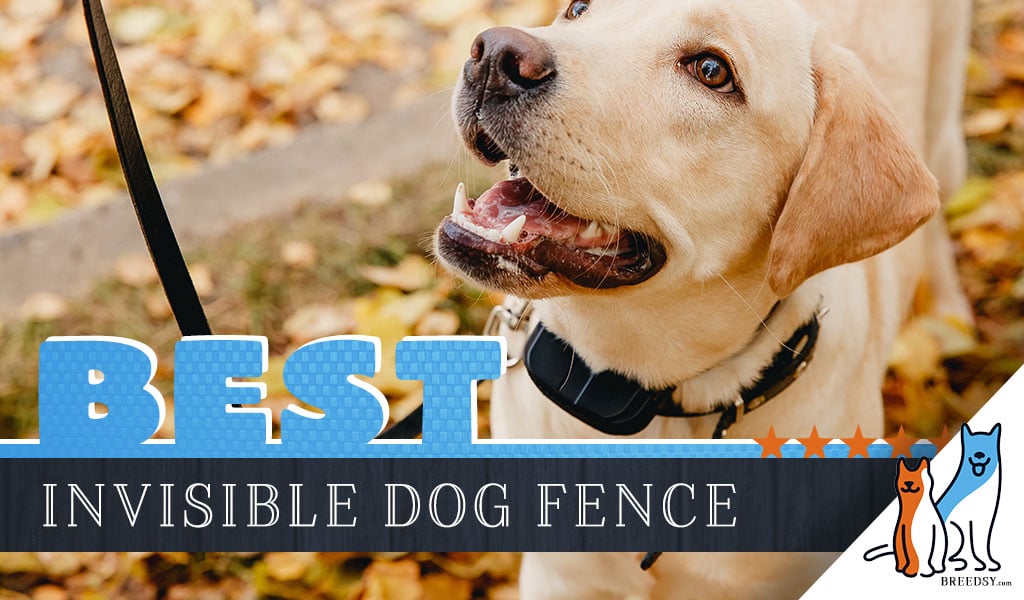
Contents
- What are the Best Invisible (Underground) Dog Fences? Here you go..
- Key Components to an Invisible Dog Fence
- Are Underground Dog Fences Safe for Dogs?
- True Cost of an Underground/Invisible Fence Cost
- Underground Fence Installation Guide
- Best Invisible (Underground) Dog Fences
- PROs and CONs to using an Invisible Fence
- Conclusion
Invisible or underground dog fences can be the perfect option for many dog owners. In this article we’ll discuss:
- Key components of invisible dog fences;
- The true cost of an invisible fence;
- How to install an invisible or underground fence;
- And our picks for the best invisible dog fence!
Keep reading and you’ll learn everything you need to know about choosing the best invisible (underground) dog fence.
There are many situations where an invisible fence can work better for your dog than a convention fence. If you live in a neighborhood that prohibits traditional fencing, an invisible fence can be the perfect solution. They are usually easy to install, even if you’re doing it yourself. They are not very expensive compared to other fencing. They don’t require much upkeep. And they won’t interfere with your landscaping. Depending on your dog and your setting, an invisible fence could be the right choice for you.
What are the Best Invisible (Underground) Dog Fences? Here you go..
Key Components to an Invisible Dog Fence
No matter what kind of invisible dog fence you are considering, they all generally have the following key components:
- Collar. Invisible dog fences are based on collar corrections to your dog. The collar acts as a receiver. When your dog gets too close to the invisible (underground) fence, he will receive a signal that sends a mild shock from the collar he wears. The collar should be comfortable for your dog, durable, and waterproof. It will also have a small component with contact points to give your dog a slight shock when he gets too close to the fence. Dogs with long coats have longer contact points than dogs with short hair so they can feel the correction.
- Correction levels. You have to train your dog to know the boundaries set by the invisible fence. This is usually done by setting up some small flags when you first install the fencing and giving your dog slight corrections as he approaches the flags. This way your dog learns that he’s not supposed to go near those areas. Many collars give a warning beep at first before they give a stronger correction. Once your dog learns where the restricted areas are, you can remove the flags from your yard.
- Boundary flags. Boundary flags are used to map out the area where you bury your cable for the invisible fencing. As you train your dog to know the restricted area, they indicate his borders. Boundary flags usually come with invisible fence kits but you can buy extras.
Transmitter/control panel. The control panel broadcasts the signal that is sent to your dog’s collar. It is usually installed in an inconspicuous place in your home such as the garage. - Underground cable/wire. The signal from the control panel travels along the cable that is buried along the perimeter that you have selected on your property. The underground cable/wire is buried just below the surface of your yard, where you have selected your dog’s boundaries to be. The lower the wire gauge number, the bigger the wire. Professional wire gauge is 14 gauge. There are some DIY homeowner systems available with 14 gauge. Most DIY systems are around 20 gauge.
- Frequencies. Invisible fences, whether wireless or in-ground, operate on AM or FM frequencies. You have to make sure that your fence system doesn’t react to other electrical systems on your property. Any equipment you purchase should transmit FCC-approved Digital Modulation signals so they won’t interfere with other signals. This will prevent false alarms and keep your fence from sending out a signal by mistake. It’s also important to prevent your fence from interfering with your neighbor’s electrical systems.
Important extras
- Protection – An invisible fence also needs lightning and surge protection. A strong electrical discharge can disrupt your fence so this equipment can protect your fence from damage.
- Wire-break indicator – If your dog starts to escape from your yard, you probably have a break in your fence somewhere. This can be a real problem if you have an in-ground fence where the break point is not easy to find, especially if you have hundreds of feet of wiring. A wire-break indicator can warn you that you have a break and pinpoint where the break is, saving you lots of unnecessary work.
- Battery life indicator – As you might guess, your dog’s collar operates with a battery. Make sure the collar has a battery life indicator so you know when the battery is dying and needs to be recharged. Some batteries will last for months but you should check your packaging or manual to see how long the battery is supposed to last. Check the battery often to make sure it’s still working. It helps to have some extra batteries on hand in case the battery dies. Batteries for these collars tend to be on the expensive side so this is something you should plan for in advance.
Are Underground Dog Fences Safe for Dogs?
Yes, underground fences are considered to be safe for dogs. There is nothing harmful about the fencing or the use of the collar to keep the dog inside the invisible fence. The electric charge a dog receives when he gets too close to the boundary is mild. It’s more of a surprise or irritant than any kind of pain. Plus, with most collars, the shock is preceded by a warning beep, so a dog has time to move away from the perimeter area before he receives a shock. Any dog that is kept inside an underground dog fence is supposed to be trained so that he understands where the boundaries are.
If you have any concerns about the shock from the collar, you can hold it in your hand, touching the contact points, and move it over your invisible fence line to see the kind of shock it produces. It’s not pleasant but it certainly won’t harm you.
There are concerns about using an underground dog fence because they don’t keep other animals out of your yard. They won’t prevent a stranger or someone from coming into your yard and taking your dog where a traditional fence might be more of a deterrent. But as far as the fence itself being any kind of danger to your dog, no. And neither is the collar.
True Cost of an Underground/Invisible Fence Cost
The cost of an underground/invisible fence will vary somewhat depending on how large an area you plan to enclose. However, there are some basic costs that you can estimate.
- Collar/receiver for one dog: $50
- Wiring/cable: $50
- Charger: $50-300
- Voltage meter: $5-30
- Batteries: $60-90/annually
You can purchase an invisible fence package that comes with the collar for between $100 and $400. This doesn’t include installation or any extras. If you have more than one dog, you will need to buy more collars. If you are enclosing a larger area, you will need to buy more wire.
Installation of an underground fence typically costs between $949 and $1,456, with $1,159 as the average. Costs can vary depending on where you live and who does the work.
Underground Fence Installation Guide
Before beginning the installation, you will need some tools:
- Wire strippers
- Straight-edged spade or shovel
You will also need:
- Electronic pet containment system
- Silicone caulk
- Electrical tape
Preparing for installation
Before you begin, you need to determine how large an area you will be enclosing so you can purchase the right containment system. Most basic underground fence systems include a transmitter that will allow you to enclose an area that’s about 25 acres. You can purchase transmitters that cover larger areas. If you plan to cover a bigger area, you will need to buy more wire. Most pet containment systems come with 500 feet of wire. This is enough to enclose about 1/3 acre.
You can use graph paper to plot your yard and fill in the area you plan to enclose. Corners usually need to be rounded because the transmitter can be confused by right angles. The wire used for the fence boundary has to make one continuous loop back to your transmitter without crossing itself.
If you have to cross brick, asphalt, or concrete surfaces, you will need a circular saw that’s fitted with a masonry blade and patching compound for the surface you have to cross. If you have to cross a gravel or dirt driveway, you can protect your wire by running it through PVC pipe.
The transmitter has to be located indoors in a place where it will be dry and protected. Many people install the transmitter in their garage. The transmitter should not be located near your breaker box. You can avoid possible interference problems by keeping it away from appliances, water heaters, and air conditioning units.
Don’t put your transmitter in a barn or shed. It needs to be in a place that is secure and dry – as well as safe from the weather. If the transmitter is exposed to water or weather damage, it could cause a fire.
Most pet containment systems recommend that the wire is buried 1-3 inches beneath the surface of your yard. The wires don’t have to be underground to work but if they are above ground, in sight, you or your dog can trip over them and it’s easy for them to be cut by the lawnmower or trimmer.
Remember that before you do any digging on your property, you should always call 811 to check for underground utilities.
If you don’t know where your cable or power lines are located, check with your local utilities before you install your wire.
Don’t run your wire along with other wires such as electrical wires, phone wires, TV cables, antenna wires, or close to satellite dishes. Don’t cross power lines.
Installation Basics
- Step 1 – The first thing to do when installing your underground fence pet containment system is to set up your transmitter in a safe, dry place such as your garage. Make sure that the transmitter is grounded as recommended by the manufacturer.
- Step 2 – Refer to the layout of your property and lay the wire along the proposed boundary lines. You can cancel the signal by twisting the wires together. This can be useful when running the wire between the boundaries and the transmitter. It’s also useful when running the wire around obstacles such as a swimming pool that’s located within the containment area.
- Step 3 – Connect the ends of the boundary wires to the transmitter. Turn the system on. It’s always important to test your wires and their connectivity to make sure they are working before you move forward with burying them. Otherwise, you can end up with 500 feet of buried wire that’s not working.
- Step 4 – Test your dog’s collar to make sure it’s working and receiving a signal from the transmitter. The collar should emit an audible warning as you get close to the boundary/wire. You can also test the shock that the collar gives at this time if you want to see what your dog will feel. It’s not very strong so it won’t hurt you or your dog but many people are curious about how it feels.
- Step 5 – When you have made sure that everything is working properly, use your spade or shovel to start digging a small trench 1 to 3 inches deep along your planned boundary line. Don’t run your boundary wire close to chain-link fences.
If your system doesn’t have as much wire as you need, you will have to splice more wire with wire connectors. If you need more wire, buy the kind of wire that is specified in the manual that comes with your pet containment system.
If you need to splice wires, just strip both ends of the wires – the wire you started with and the new wire. Insert the stripped ends into the wire connector and twist. You can test the spliced wires by giving a pull to make sure there is a solid connection. Apply some silicone caulk in and around the wire connector to keep them in place. After the caulk dries you can also wrap the wires and the connector with some electrical tape.
Continue digging your trench and laying your wire.
If you have to cross concrete or pavement, use a circular saw with a masonry blade to cut a trench for the wire. Remember to wear safety glasses to protect your eyes. You can patch the surface after the wire has been installed and tested. Don’t patch the surface until you are sure the system is working. - Step 6 – Some underground/invisible fences are very susceptible to lightning strikes and power surges. Make sure you ground your system to protect it from damage. Your system should come with instructions for grounding so be sure to follow these precautions. They could save your system from severe damage.
- Step 7 – Even though the wires for your invisible fence are underground, there will be a couple of places where the wires enter and exit above ground to attach to your transmitter. Be sure to keep these areas trim and free from weeds, tall grass, and anything that could break the signal.
- Step 8 – After you finish installing your underground/invisible fence system, all that remains is for you to set up boundary flags on your property, put the collar on your dog, and begin training him so he will know where he’s allowed to go – and not go. Take your time with this training since it can be the most important part of how well an invisible fence works. The biggest reason that invisible fences fail to contain dogs is because owners don’t train their dogs to understand collar corrections and boundaries. Your fence will probably work but if you really want your dog to enjoy his yard and stay away from the perimeter, spend time teaching him with the flags that are provided with most systems.
Best Invisible (Underground) Dog Fences
| Our 2024 Picks: Best Underground Dog Fences | |||
| Rank | Dog Fence | Price | Rating |
|
Overall |
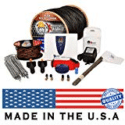 EXtreme In-Ground Electric Dog Fence Easy Installation D.I.Y. Kit 2nd Generation (2018) |
$$$ |
A+
|
|
#2 |
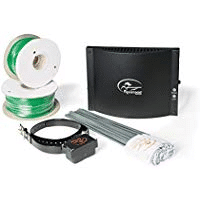 |
$$$ |
A+
|
|
#3 |
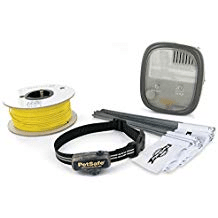 |
$$$ |
A+
|
|
#4 |
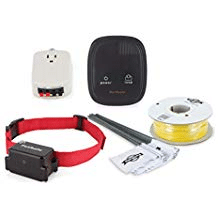 |
$$ |
A
|
|
#5 |
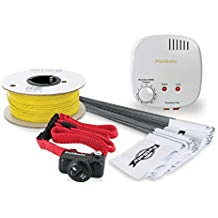 |
$$ |
A-
|
eXtreme In-Ground Electric Dog Fence Easy Installation D.I.Y. Kit 2nd Generation (2018)
We checked a lot of underground fence sites and read a lot of reviews. The eXtreme In-Ground Electric Dog Fence Easy Installation D.I.Y. Kit was consistently ranked as the best or one of the best invisible/underground fence systems available. It has some great features, so it’s easy to see why.
The 2nd Generation covers 25 acres (up from 10 in the earlier version). The collar is completely waterproof – not just water-resistant. Your dog can swim while wearing the collar and it won’t stop it from working. The pro grade fence kit includes 14-gauge heavy duty boundary wire which is exactly like professional invisible fence installers use. It has a surge protector, a digital transmitter, training flags, splice kits, and more. This underground fence comes with a 10-year guarantee on the electronics and a lifetime guarantee on the fence wire. They guarantee that the fence will contain your dog. Made in the U.S.A. And, they offer 24-hour assistance and support in setting up your fence, training your dog, and troubleshooting any issues. You can buy packages that contain up to 2500 feet of pro grade fencing. Comes in systems for 1 to 5 dogs. The 1-dog system with 500 feet of pro grade fence is $339.94 on Amazon.com.
SportDOG Brand In-Ground Fence System

The collar offers four static corrections to give you some options. It’s also waterproof and fits dogs as small as 10 pounds which is helpful for people with small dogs. This system also has a wire break alarm on the transmitter to alert you if there is a break in the underground wire somewhere. Available for $259.95 on Amazon.com.
PetSafe Elite Little Dog In-Ground Fence
PetSafe Elite Little Dog In-Ground Fence works for dogs as small as 5 pounds. Fits dogs with neck sizes from 6 to 16 inches. The collar is adjustable and waterproof. Corrections can be made in four levels including a tone for training. The reflective collar strap also adds visibility at night. The collar also has a low battery indicator so you know when to replace batteries.
The complete system covers 1/3 acre but can be expanded to cover up to 25 acres with more wire and flags. PetSafe is a leader in invisible fencing. Available from Amazon.com for just $209.95.
PetSafe Stubborn Dog In-Ground Fence for Dogs
PetSafe Stubborn Dog In-Ground Fence for Dogs is perfect for that dog that just won’t stay in the yard. It’s designed for large, energetic dogs. The collar has four levels of static correction. The highest level is about 50 percent stronger than normal collars. Includes a vibration option for deaf dogs or as an alternative to static correction. One level is tone-only. You can add an unlimited number of dogs to the system with the purchase of extra collars. The collar is waterproof and uses the PetSafe 9-volt alkaline battery (1 battery included).
The standard system comes with 20 gauge copper insulated wire but you can upgrade to 18 gauge, 16 gauge, or even 14 gauge. (Using 14 gauge wire will take some extra work to fit into the transmitter, according to the company.) Other features: the collars fit dogs that weigh 8 pounds and up with neck sizes 6 to 28 inches. The system can be expanded up to 10 acres with additional wire. Comes with enough wire to cover 1/3 acre. Comes with a transmitter with power adapter; receiver collar and battery; test light tool; operating and training guide; 50 boundary training flags; 500 feet of boundary wire; wire nuts; gel-filled capsules. Available from Amazon.com for $199.95.
PetSafe Basic In-Ground Fence
If you’re looking for a basic underground/invisible fence for your dog and budget is a concern, then the PetSafe Basic In-Ground Fence is probably your best bet. This system gets good marks from various online reviewers and customers. PetSafe makes quality in-ground fence products. And it has all of the necessary features to keep most dogs contained.
Key features include: enough wire to enclose up to 1/3 of an acre; can be expanded to cover up to 5 acres if you buy more wire and flags. Uses 14-20 gauge copper insulated wire. The lightweight receiver collar is designed for dogs that weigh 8 pounds and up, with neck sizes from 6 to 26 inches. The collar is waterproof with 4 levels of static correction plus a tone-only mode or training. The collar also has a low battery indicator. Batteries usually last 1-2 months before they need to be replaced. System comes with a surge protector to protect your transmitter from lightning strikes and electrical surges. $129.95 from Amazon.com.
PROs and CONs to using an Invisible Fence
Now that you’ve learned about invisible fences, here are some final pros and cons to consider.
Pros
- Invisible fences are more affordable than traditional fencing for many owners;
- You don’t have to alter your landscaping;
- They keep your dog safely contained;
- They satisfy zoning requirements in some towns and neighborhoods that prohibit other kinds of fencing;
- There is very little maintenance;
- Most people can install an invisible/underground fence by themselves;
- Trains your dog to stay within his boundaries.
Cons
- You have to check the collar batteries regularly;
- Installation does take some time and effort;
- Expense can vary depending on the size of your property;
- Your dog is not protected from other dogs or animals that intrude into your yard;
- Your dog has no protection from any strangers that come into your yard;
- Invisible/underground fences can fail to work if you don’t train our dog properly using the flags and teaching him about the boundaries of his yard. This is the biggest reason an invisible fence fails to keep a dog contained so make sure you spend time working with your dog after the fence is installed.
Conclusion
Invisible/underground fences can be a good option for many dog owners, especially if they live in an area where a conventional fence won’t work. Invisible fences are generally easy to install and they are less expensive than traditional fences. As long as you spend time training your dog so he understands the collar corrections and the boundaries, invisible fences successfully keep most dogs contained. There are many good invisible fence systems available today. Consider which features are important to you and choose one that will work for your dog. If you don’t need to cover 100 acres, then there’s probably no need to worry about choosing a system that covers that much property. Keeping your dog safely contained in your yard is what matters.

